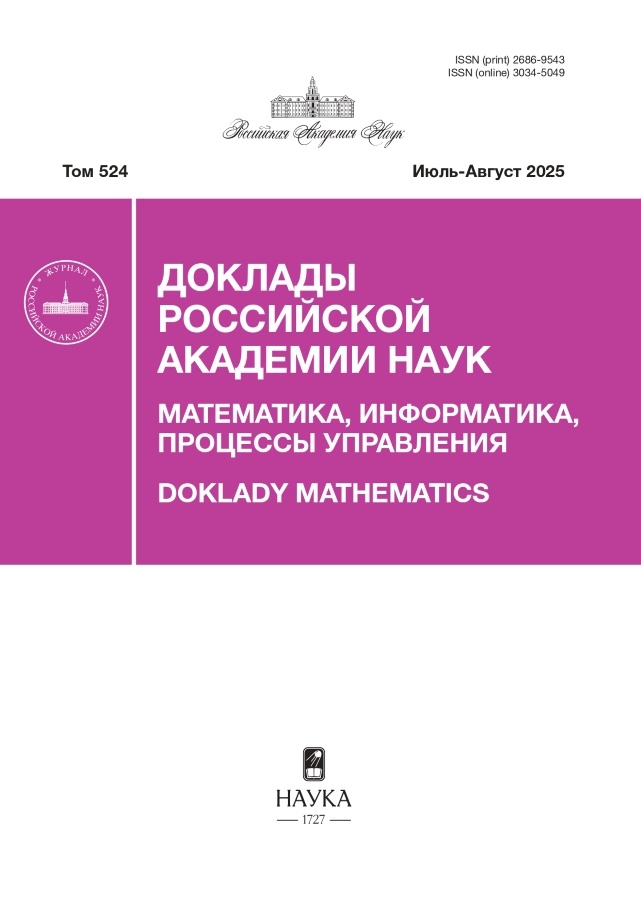On the accuracy of calculating invariants in centered rarefaction waves and in their influence area
- Authors: Ostapenko V.V.1, Polunina E.I.1, Khandeeva N.A.1
-
Affiliations:
- Lavrentyev Institute of Hydrodynamics, Siberian Branch, Russian Academy of Sciences
- Issue: Vol 518 (2024)
- Pages: 65-74
- Section: MATHEMATICS
- URL: https://rjeid.com/2686-9543/article/view/647998
- DOI: https://doi.org/10.31857/S2686954324040109
- EDN: https://elibrary.ru/YYRMQN
- ID: 647998
Cite item
Abstract
We perform a comparative analysis of the accuracy of second-order TVD (Total Variation Diminishing), third-order RBM (Rusanov-Burstein-Mirin), and fifth-order in space and third-order in time A-WENO (Alternative Weighted Essentially Non-Oscillatory) difference schemes for solving a special Cauchy problem for shallow water equations with discontinuous initial data. The exact solution of this problem contains a centered rarefaction wave and does not contain a shock wave. It is shown that in the centered rarefaction wave and its influence area, the solutions of these three schemes with different orders converge to different invariants of the exact solution. This leads to a decrease in the accuracy of these schemes when calculating the vector of base variables of the considered Cauchy problem. The P-form of the first differential approximation of the difference schemes is used for the theoretical justification of these numerical results.
Full Text
About the authors
V. V. Ostapenko
Lavrentyev Institute of Hydrodynamics, Siberian Branch, Russian Academy of Sciences
Author for correspondence.
Email: ostigil@mail.ru
Russian Federation, Novosibirsk
E. I. Polunina
Lavrentyev Institute of Hydrodynamics, Siberian Branch, Russian Academy of Sciences
Email: ekpolunina2014@gmail.com
Russian Federation, Novosibirsk
N. A. Khandeeva
Lavrentyev Institute of Hydrodynamics, Siberian Branch, Russian Academy of Sciences
Email: nzyuzina1992@gmail.com
Russian Federation, Novosibirsk
References
- Ковыркина О.А., Остапенко В.В. О построении комбинированных разностных схем повышенной точности // Докл. АН. 2018. Т. 478. № 5. 517–522. https://doi.org/10.1134/S1064562418010246
- Cockburn B. An introduction to the discontinuous Galerkin method for convection-dominated problems, advanced numerical approximation of nonlinear hyperbolic equa-tions // Lect. Notes Math. 1998. V. 1697. 150–268. https://doi.org/10.1007/BFb0096353
- Куликовский А.Г., Погорелов Н.В., Семенов А.Ю. Математические вопросы численного решения гиперболических систем уравнений. М.: Физматлит, 2001.
- LeVeque R.J. Finite-volume methods for hyperbolic problems. Cambridge: Cambridge University Press, 2002. https://doi.org/10.1017/CBO9780511791253
- Toro E.F. Riemann solvers and numerical methods for fluid dynamics: a practical intro-duction. Berlin: Springer-Verlag Berlin Heidelberg, 2009.
- Hesthaven J.S. Numerical methods for conservation laws. // Computational Science and Engineering 18. SIAM, 2018. https://doi.org/10.1137/1.9781611975109
- Shu C.-W. Essentially non-oscillatory and weighted essentially non-oscillatory schemes // Acta Numer. 2020. V. 29. 701–762. https://doi.org/10.1017/S0962492920000057
- Gelb A., Tadmor E. Adaptive edge detectors for piecewise smooth data based on the minmod limiter // J. Sci. Comput. 2006. V. 28. 279–306. https://doi.org/10.1007/s10915-006-9088-6
- Guermond J.L., Pasquetti R., Popov B. Entropy viscosity method for nonlinear conservation laws // J. Comput. Phys. 2011. V. 230. 4248–4267. https://doi.org/10.1016/j.jcp.2010.11.043
- Dewar J., Kurganov A., Leopold M. Pressure-based adaption indicator for compressible Euler equations // Numer. Meth. Part. Diff. Eq. 2015. V. 31. № 6. 1844–1874. https://doi.org/10.1002/num.21970
- Брагин М.Д., Ковыркина О.А., Ладонкина М.Е., Остапенко В.В., Тишкин В.Ф., Хандеева Н.А. Комбинированные численные схемы // Ж. вычисл. матем. и матем. физ. 2022. Т. 62. № 11. 1763–1803. https://doi.org/10.1134/S0965542522100025
- Chu S., Kovyrkina O.A., Kurganov A., Ostapenko V.V. Experimental convergence rate study for three shock-capturing schemes and development of highly accurate com-bined schemes // Numer. Meth. Part. Diff. Eq. 2023. V. 39. № 6. 4317–4346. https://doi.org/10.1002/num.23053
- Ковыркина О.А., Остапенко В.В. О точности разностных схем при расчете центрированных волн разрежения // Матем. моделир. 2023. Т. 35. № 7. 83–96. https://doi.org/10.1134/S2070048223070104
- Годунов С.К. Разностный метод численного расчета разрывных решений уравнений гидродинамики // Матем. сборник. 1959. Т. 47. № 3. 271–306.
- Harten A. High resolution schemes for hyperbolic conservation laws // J. Comput. Phys. 1983. V. 49. № 3. 357–393. https://doi.org/10.1016/0021-9991(83)90136-5
- Jiang G.S., Shu C.-W. Efficient implementation of weighted ENO schemes // J. Com-put. Phys. 1996. V. 126. № 1. 202–228. https://doi.org/10.1006/jcph.1996.0130
- Русанов В.В. Разностные схемы третьего порядка точности для сквозного счёта разрывных решений // Докл. АН СССР. 1968. Т. 180. № 6. 1303–1305.
- Burstein S.Z., Mirin A.A. Third order difference methods for hyperbolic equations // J. Comput. Phys. 1970. V. 5. № 3. 547–571. https://doi.org/10.1016/0021-9991(70)90080-X
- Wang B.S., Don W.S., Garg N.K. and Kurganov N.K. Fifth-order A-WENO finite-difference schemes based on a new adaptive diffusion central numerical flux // SIAM J. Sci. Comput. 2020. V. 42. A3932–A3956. https://doi.org/10.1137/20M1327926
- Шокин Ю.И., Яненко Н.Н. Метод дифференциального приближения. Новосибирск: Наука, 1985.
- Ковыркина О.А., Курганов А.А., Остапенко В.В. Сравнительный анализ точности трех различных схем при расчете ударных волн // Матем. моделир. 2022. Т. 34. № 10. 43–64. https://doi.org/10.1134/S2070048223030092
- Ковыркина О.А., Остапенко В.В. О точности схемы типа MUSCL при расчете разрывных решений // Матем. моделир. 2021. Т. 33. № 1. 105–121. https://doi.org/10.1134/S2070048221050136
Supplementary files















